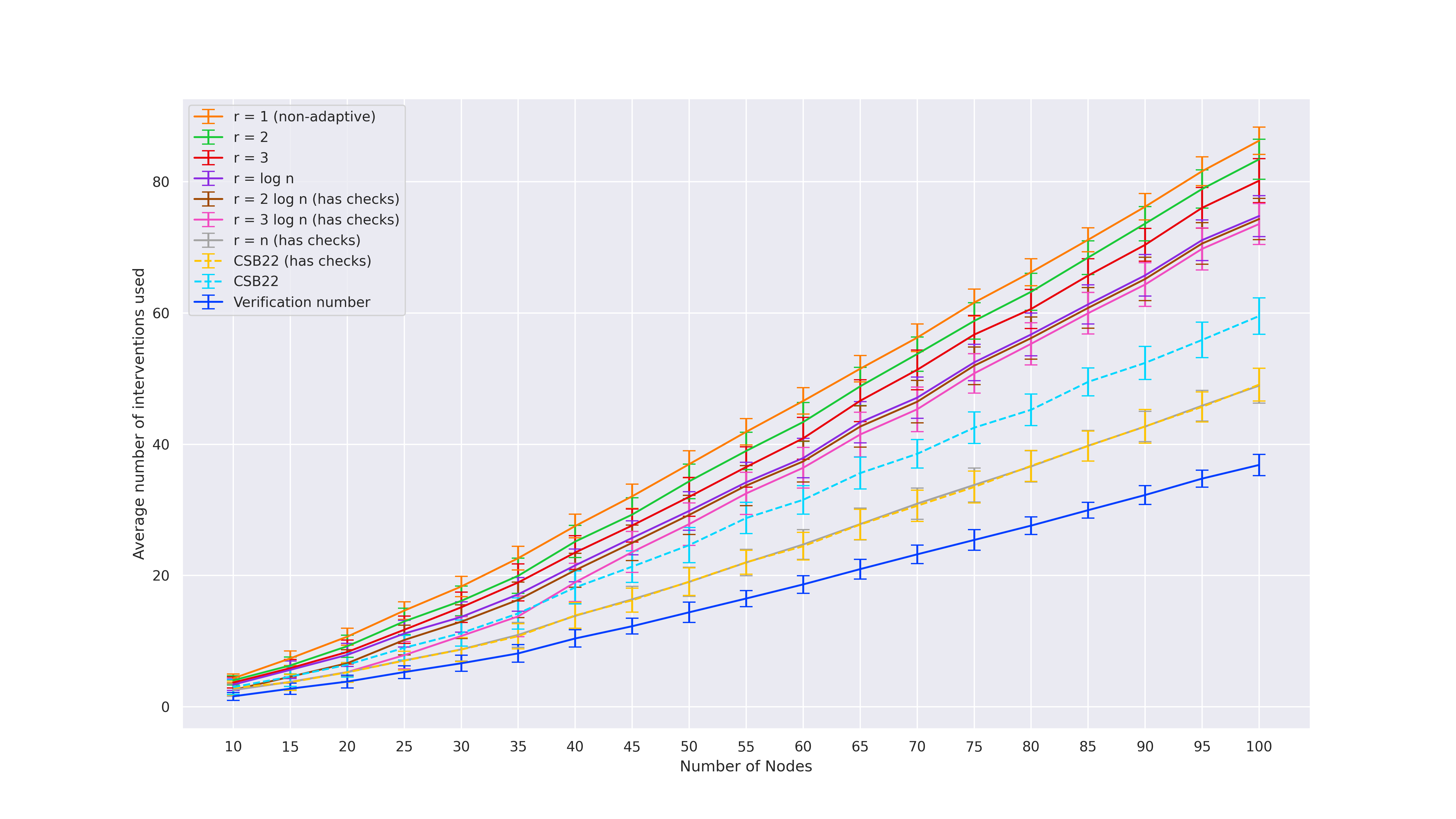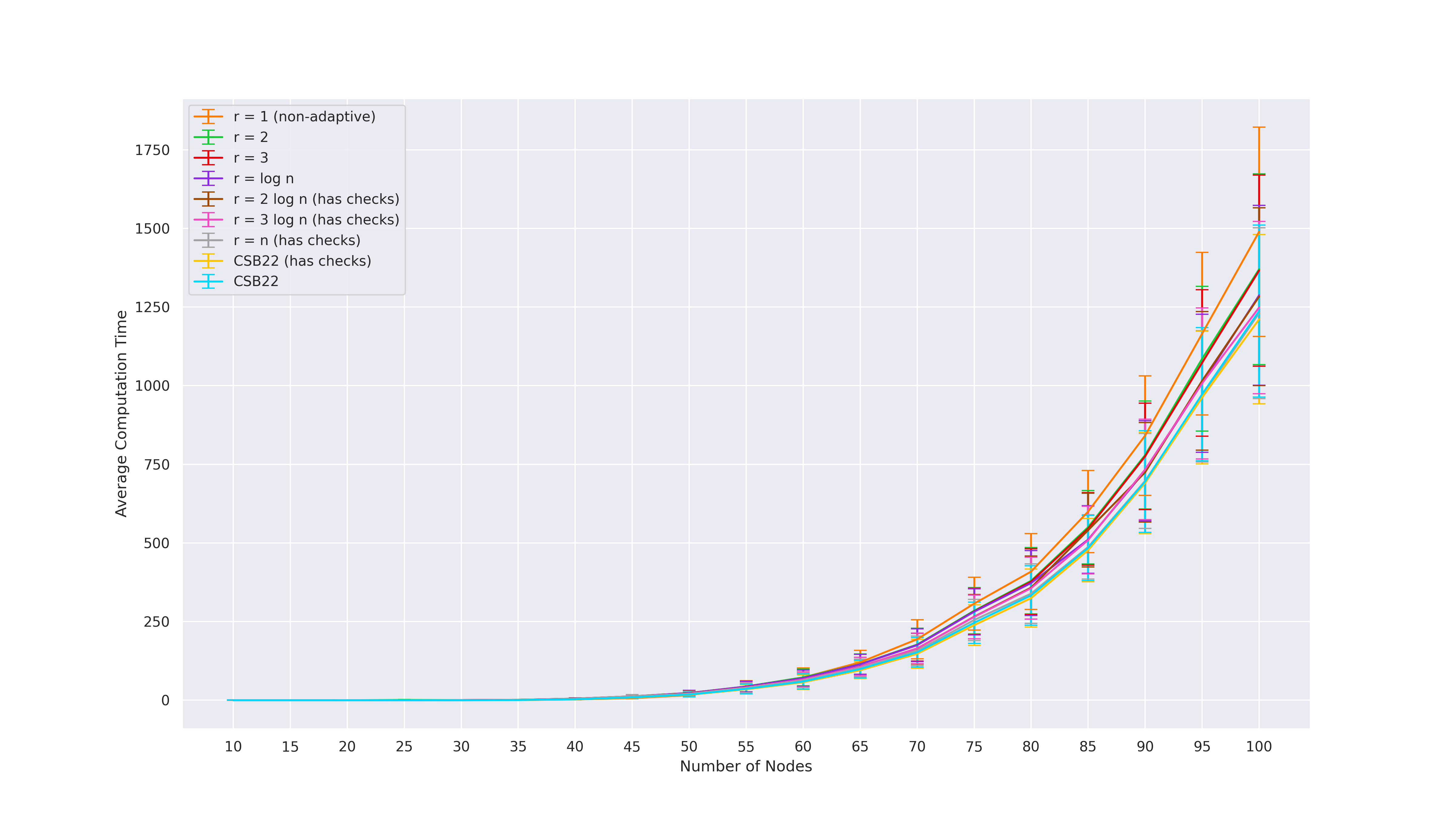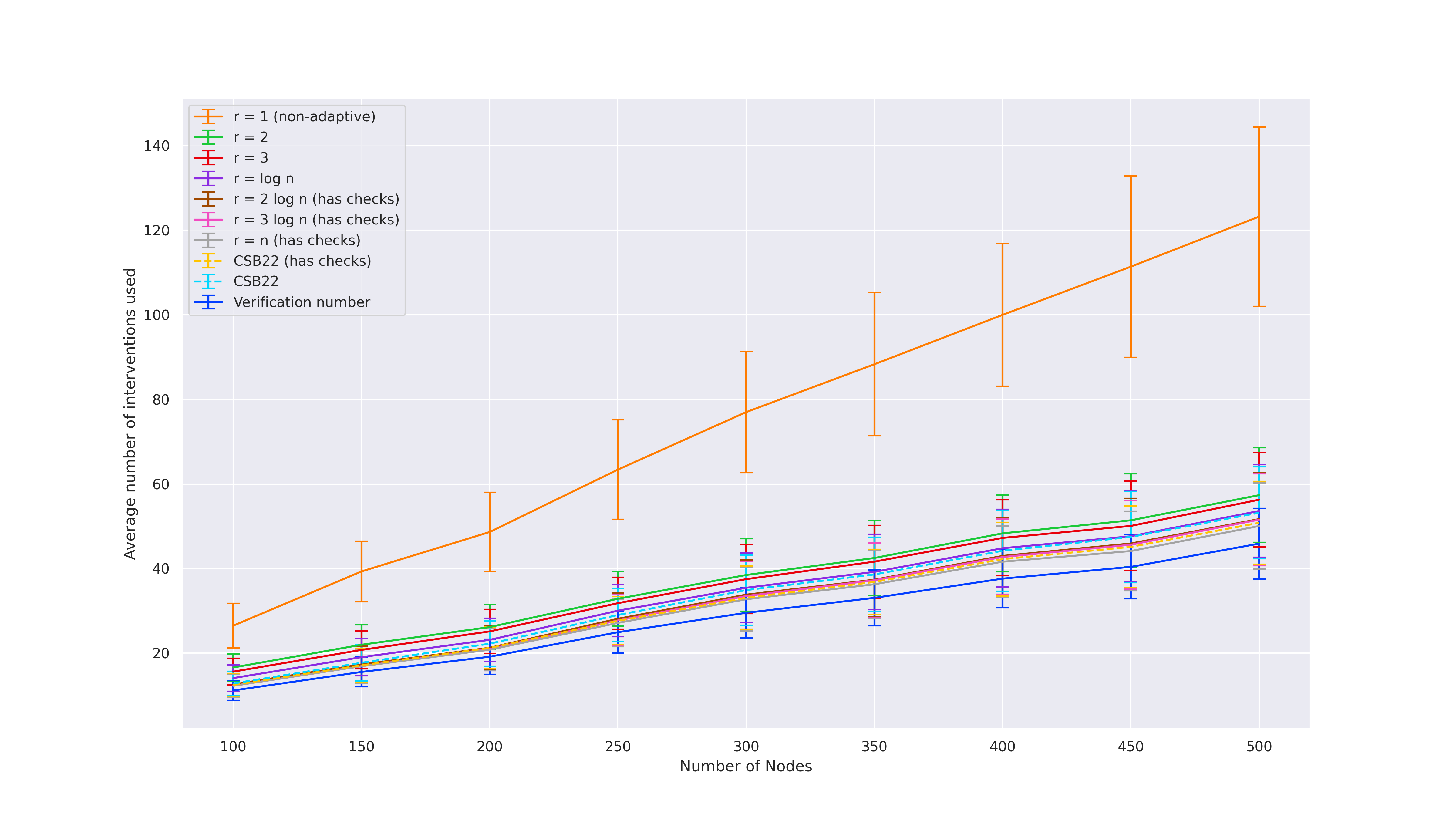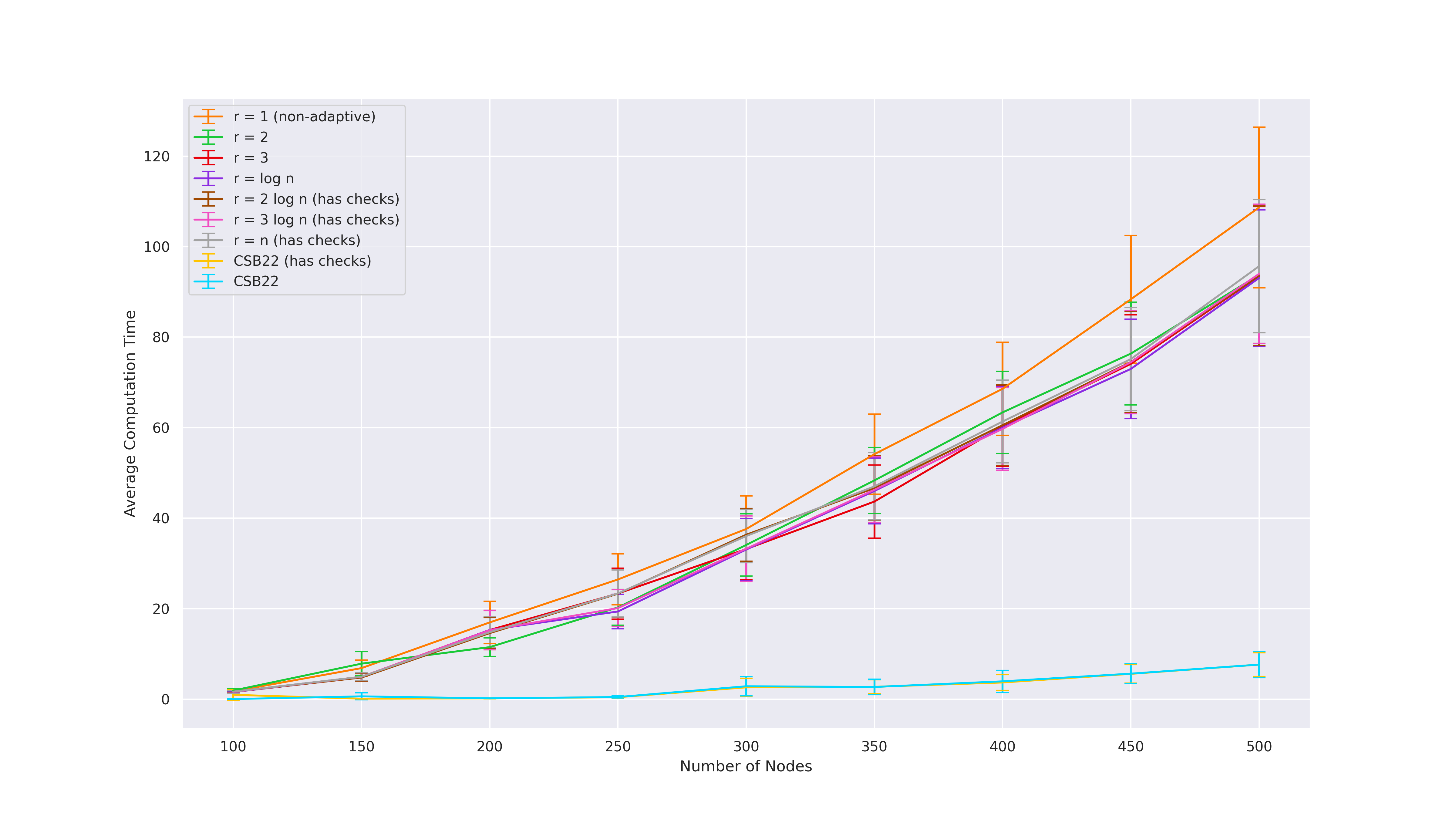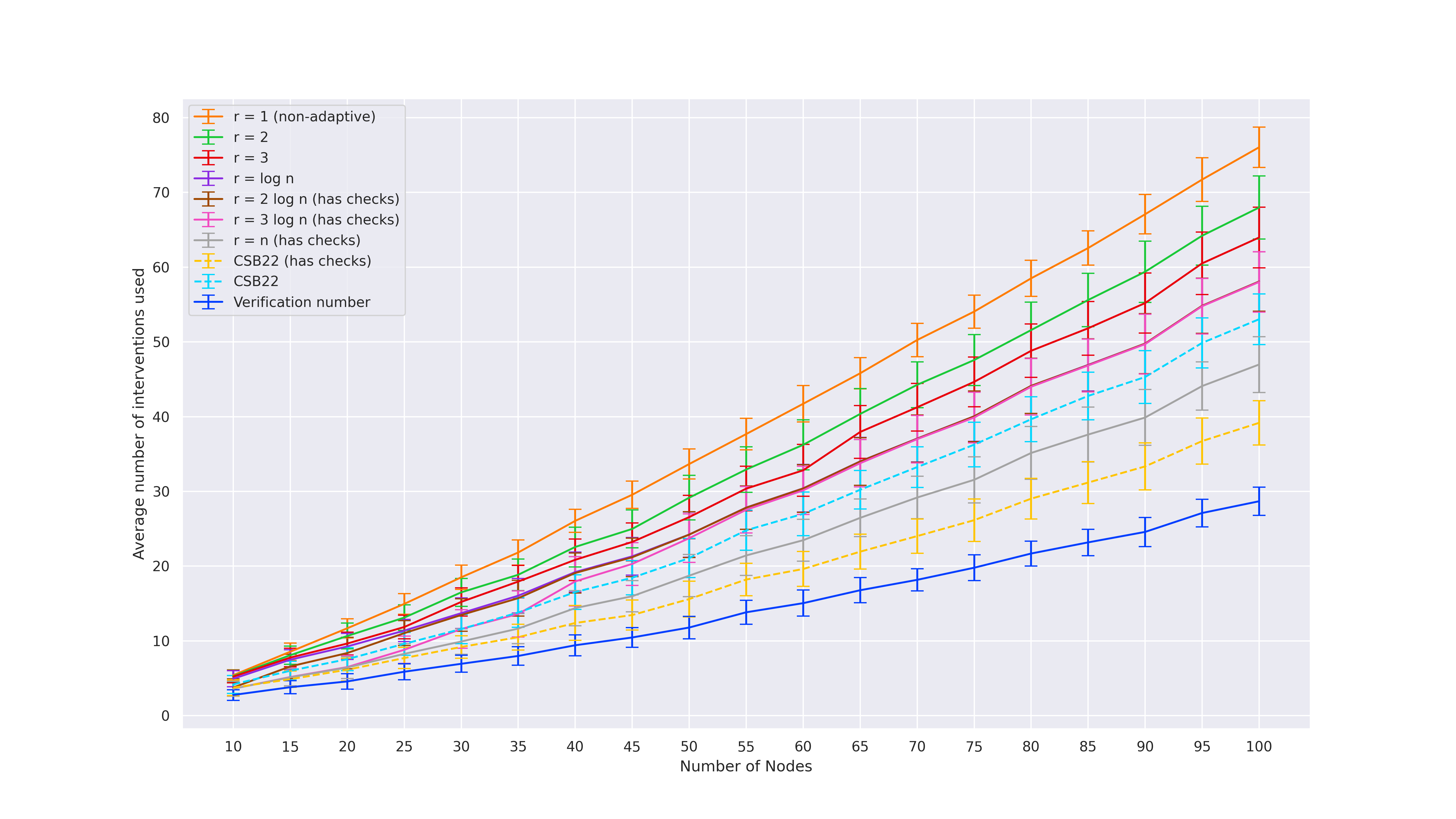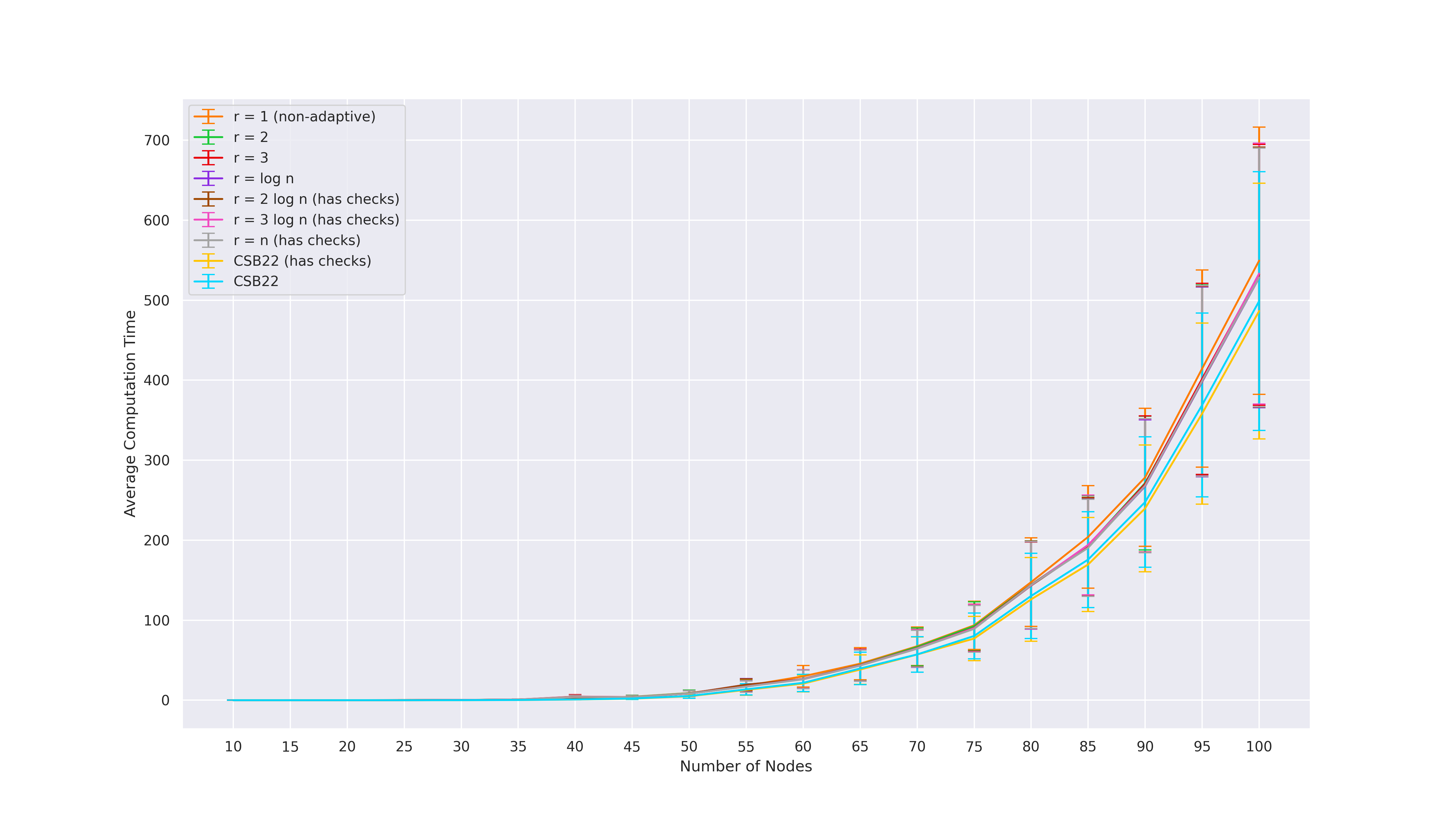This is the accompanying repository of the Accompanying repository for "Adaptivity Complexity for Causal Graph Discovery". It is available at https://arxiv.org/abs/2306.05781.
We have included a copy of the produced figures sub-directory in here so you may look at the output without running the experiments yourself.
The current implementation of [CSB22]'s separator algorithm is actually
Since
For the final round of interventions, let
Note that we can always compute the intervention set
We use synthetic moral randomly generated graphs from earlier prior works [SMG+20,CSB22,CS23]. For each of the graph classes and parameters, we generate 100 DAGs and plot the average with an error bar.
-
Erdős-Rényi styled graphs (used by [SMG+20,CSB22])
These graphs are parameterized by 2 parameters: number of nodes$n$ and density$\rho$ . Generate a random ordering$\sigma$ over$n$ vertices. Then, set the in-degree of the$n^{th}$ vertex (i.e.\ last vertex in the ordering) in the order to be$X_n = \max\{1, \texttt{Binomial}(n-1, \rho)\}$ , and sample$X_n$ parents uniformly form the nodes earlier in the ordering. Finally, chordalize the graph by running the elimination algorithm of [KF09] with elimination ordering equal to the reverse of$\sigma$ .
Parameters used:$n = \{10, 15, 20, \ldots, 95, 100\}$ and$\rho = 0.1$ . -
Tree-like graphs (used by [SMG+20,CSB22])
These graphs are parameterized by 4 parameters: number of nodes$n$ , degree$d$ ,$e_{\min}$ , and$e_{\max}$ . First, generate a complete directed$d$ -ary tree on$n$ nodes. Then, add$\texttt{Uniform}(e_{\min}, e_{\max})$ edges to the tree. Finally, compute a topological order of the graph by DFS and triangulate the graph using that order. As the original definition of this graph class by [SMG+20] becomes very sparse as$n$ grows, we tweaked the other parameters to scale accordingly by defining new parameters$d_{prop}, e_{\min, prop}, e_{\max, prop} \in [0,1]$ as follows:$d = n \cdot d_{prop}$ ,$e_{\min} = n \cdot e_{\min, prop}$ , and$e_{\max} = n \cdot e_{\max, prop}$ .
Parameters used:$n = \{100, 150, 200, \ldots, 450, 500\}$ ,$d_{prop} = 0.4$ ,$e_{\min, prop} = 0.2$ ,$e_{\max, prop} = 0.5$ . -
$G(n,p)$ -union-tree (used by [CS23])
These graphs are parameterized by 2 parameters: number of nodes$n$ and edge probability$p$ . An Erdős-Rényi$G(n,p)$ and a random tree$T$ on$n$ vertices are generated. Take the union of their edge sets, orient the edges in an acyclic fashion, then add arcs to remove v-structures.
Parameters used:$n = \{10, 15, 20, \ldots, 95, 100\}$ and$p=0.03$ .
While both the algorithm of [CSB22] and our Algorithm 2 have been implemented to take in a parameter
-
separator: Algorithm of [CSB22]. With checks, it allows for full adaptivity. -
separator_no_check:separatorbut we remove checks that avoid redundant interventions, i.e.$\mathcal{O}(\log n)$ rounds of adaptivity. -
adaptive_r1: Our Algorithm 2 with$r = 1$ , i.e. non-adaptive -
adaptive_r2: Our Algorithm 2 with$r = 2$ -
adaptive_r3: Our Algorithm 2 with$r = 3$ -
adaptive_rlogn: Our Algorithm 2 with$r = \log_2 n$ -
adaptive_r2logn: Our Algorithm 2 with$r = 2 \log_2 n$ . Can perform checks that avoid redundant interventions. -
adaptive_r3logn: Our Algorithm 2 with$r = 3 \log_2 n$ . Can perform checks that avoid redundant interventions. -
adaptive_rn: Our Algorithm 2 with$r = n$ , i.e. full adaptivity allowed
As expected, we observe that higher rounds of adaptivity leads to lower number of interventions required.
When
[This paper] Davin Choo and Kirankumar Shiragur. Adaptivity Complexity for Causal Graph Discovery. Conference on Uncertainty in Artificial Intelligence, 2023. Available at https://arxiv.org/abs/2306.05781
[G72] Fănică Gavril. Algorithms for minimum coloring, maximum clique, minimum covering by cliques, and maximum independent set of a chordal graph. SIAM Journal on Computing, 1(2):180–187, 1972. Available at: https://epubs.siam.org/doi/abs/10.1137/0201013?journalCode=smjcat
[L84] Joseph Y-T Leung. Fast algorithms for generating all maximal independent sets of interval, circular-arc and chordal graphs. Journal of Algorithms, 5(1):22–35, 1984. Available at: https://www.sciencedirect.com/science/article/abs/pii/0196677484900373
[KF09] Daphne Koller and Nir Friedman. Probabilistic graphical models: principles and techniques. MIT press, 2009. Available at: https://mitpress.mit.edu/9780262013192/probabilistic-graphical-models
[KDV17] Murat Kocaoglu, Alex Dimakis, and Sriram Vishwanath. Cost-Optimal Learning of Causal Graphs. In International Conference on Machine Learning, pages 1875–1884. PMLR, 2017. Available at: https://arxiv.org/pdf/1703.02645.pdf
[SMG+20] Chandler Squires, Sara Magliacane, Kristjan Greenewald, Dmitriy Katz, Murat Kocaoglu, and Karthikeyan Shanmugam. Active Structure Learning of Causal DAGs via Directed Clique Trees. Advances in Neural Information Processing Systems, 2020. Available at: https://arxiv.org/pdf/2011.00641.pdf
[CSB22] Davin Choo, Kirankumar Shiragur, and Arnab Bhattacharyya. Verification and search algorithms for causal DAGs. Advances in Neural Information Processing Systems, 2022. Available at https://arxiv.org/pdf/2206.15374.pdf
[CS23] Davin Choo and Kirankumar Shiragur. Subset verification and search algorithms for causal DAGs. International Conference on Artificial Intelligence and Statistics, 2023. Available at https://arxiv.org/pdf/2301.03180.pdf.
